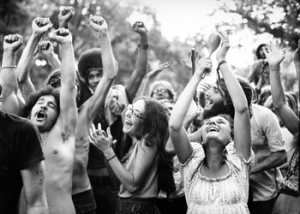
When I was compiling my lists of songs about narcissism, it didn’t pass my notice how few songs there were prior to the 1980s that focused on it. Oh sure, there have always been a few here and there (Carly Simon’s 1972 hit “You’re So Vain” immediately comes to mind) and there were always those “you/he/she done me wrong” love songs, but songs specifically about narcissism were pretty rare.
I think the reason for this is because it wasn’t until the 1980s that narcissism became so dominant in western (especially American) culture that it became a new virtue–something to aspire to if you wanted to be financially and professionally successful. And it wasn’t until the 1990s that narcissism became recognized as a real problem and websites, blogs and forums about narcissistic abuse began to spring up all over the Internet.
But I think the problem really started long before that, back in the post-WWII days when the Baby Boomers started being born. Of course there are exceptions, but as a generation, the Boomer generation was raised to be grandiose, entitled and lack a collective sense of empathy for others. As the Boomers aged, their collective sense of entitlement bled over into everything they touched–politics, business, and the culture at large. Today this narcissism affects all living generations, but generations older than the Boomers generally frowned on it.
1950s.

After our WWII victory, America became very hubristic. We had become a superpower to be reckoned with the world over, and American life never seemed better. Life was very different than it had been even a decade earlier, and most newlyweds now had TVs, new kitchens with modern appliances that made a wife’s job much easier and left her more time to spend with her children, and often two cars. Employment was high and jobs paid well compared to the cost of living at the time. Young husbands were able to afford to buy tract homes and new cars on the GI bill, and could afford to support a wife and children. Of course, these were very conformist times too, and “keeping up with the Joneses” was a thing.
Enter the victory babies born in this national mood of optimism following the war: the Baby Boomers. Raised according to Dr. Benjamin Spock’s indulgent philosophy of “feeding on demand” and “Johnny will clean up his room when he feels like cleaning up his room,” Boomer infants and toddlers were pampered, indulged, and trained to be entitled. They were given anything they wanted and discipline tended to be light and consist of trying to “reason” with children. There was an endless array of new toys and snacks marketed to children, and mothers were made to feel like bad parents if they refused to comply with what advertisers told them to buy. The kids caught onto this attitude of entitlement, and if Sally got the new Barbie doll or Eric got the new battery operated toy truck, then Debbie and Paul had to have them too. The culture at the time was child-centered. It was a given that a child’s needs and wants always came before the parents’ and children were constantly told how “special” they were.
As they entered school, young Boomers’ attitude of entitlement and specialness carried over into the classroom. As a generation, they expected to be treated as little gods and goddesses, just as their parents had treated them.
1960s.

As the Boomers entered their teens, they began to rebel against the parents who had showered attention and material comforts on them. I believe this rebellion was due to a collective fear of engulfment by overindulgent parents. They were attempting to break away by reacting against the very lifestyle that had given them so much. Of course not every child had overindulgent parents, but teenagers always try to emulate what’s popular or cool. Rebelling against “the Establishment” or the Vietnam War (which also represented the values of their parents) became hip and cool. Adolescent Boomers, having been raised to believe they were unique and special (and most of those middle class and above were able to attend college and were often the first in their family to be able to do so) embraced causes that were anathema to the values of “the old fogies” and at first, really believed their causes were superior to those of their parents. They tuned in, turned on, and dropped out. They experimented with marijuana and LSD. They dressed in hippie clothing and wore their hair long, which horrified “The Establishment.” They listened to rock music, the louder and harder and more offensive to the older generation, the better. They protested the war, attended “love ins” and participated in campus sit-ins, and eventually riots. Young Boomers believed their values were exactly what the world needed, but their attitude was based on entitlement rather than realism. They were idealists who believed the world could be changed by smoking pot and listening to the right sort of music.
Due to the sheer size of the Boomer generation, anything they did got a lot of national attention. Besides the many disapproving and negative news stories about the Vietnam protests, communal living, and recreational drug use, others were also beginning to emulate them. The next-older generation (The Silents), who had been largely ignored as they came of age, tried to seem younger by emulating the Boomers in their dress, tastes, and general lifestyle. The Boomers were never short on collective narcissistic supply (both negative and positive), and this continued to feed their attention-getting behavior.
Parents wondered where they had gone wrong, and why the children they had raised so lovingly had turned so rebellious and so insistent on “doing their own thing.” They wondered why this new generation seemed to hate them so much.
By the end of the 1960s, the “hippie lifestyle,” like everything else the Boomers would ever start, had become a lucrative market. But by the time The Establishment caught on, the Boomers were beginning to move on to other things, including embracing what they had rejected.
The power was still in the hands of the older generation of course, so narcissism had not yet become a noticeable part of the culture (although hubris and conformity definitely still was). By the 1970s, the first signs of a growing narcissistic culture would begin to make themselves felt.
1970s.

Boomers, now entering their 20s, had by now largely abandoned their earlier hippie incarnation for a more subdued “back to the land” movement, in which they opted for whole foods, fresh air, and healthy living. Others began to infiltrate the job market, often with degrees in esoteric subjects. Having children was something to be avoided, as Boomers wanted to prolong their adolescence or make a mark on the world. The Pill and newly legal abortion made all this possible. Around the same time, women began to demand equal rights in society and the workplace. The 70s wave of feminism was very anti-child and pro-career. If you preferred to marry and raise children, you were looked upon as a throwback to the 1950s.
Around the same time, various forms of non-traditional, humanist psychotherapies (EST, Esalen, etc.), grassroots religions, and cults became popular. Collectively known as “the human potential movement,” self-improvement and self-development became a priority for Boomers. Putting your own needs before those of others was not only normal, it was considered healthy. New York Magazine dubbed the 1970s “The Me Decade” for this reason. Couples opted to cohabitate rather than marry(because it was easier to break a commitment), and divorce was becoming very common. Children raised during this time (Generation X) found themselves ignored, treated as second class citizens, or sometimes even abandoned by their self-involved Boomer parents who seemed to put their own needs ahead of theirs.
Around the middle of the 1970s, a new kind of music (disco) became associated with materialism, hedonism, and over the top sexuality. By now, Boomers had done a 180 from their emergence during the 1960s as hippies, and now embraced the crass materialism they had once rejected. They were ready for a President who would encourage their pursuit of luxury and material success.
At the same time, fundamentalist Christianity, which had been “rediscovered” by some Boomers as an outgrowth of the Jesus movement of the 1960s, was becoming increasingly popular, and the new conservatism was using it as a way to attract newly saved Christian voters.
The new narcissism wasn’t lost on Christopher Lasch, who published his book, “The Culture of Narcissism,” in 1979.
1980s.

Ronald Reagan popularized trickle-down (or “supply side” economics), which basically meant allowing people to pay less taxes and keep more of what they earned. This played right into the hands of financially successful, entitled Boomers, who didn’t want to share their newfound wealth. The hippies had become the Yuppies–young urban professionals who had to “dress for success,” live to impress, and have the best of everything. Clothing wasn’t acceptable unless it had a designer’s logo on it. Housewares weren’t acceptable unless they were handmade in Outer Mongolia by native women. Food wasn’t acceptable unless it was “nouvelle cuisine.”
Having the perfect body was a priority, and Boomers started going to the gym or even personal trainers to tone and sculpt their bodies, sometimes to the point of unhealthy obsession. Boomers, mostly in their 30s by now, were finally deciding to have families, but children themselves became a status symbol, and getting your child into the “right” preschool or having the “right” designer clothing, or the “right” dance instructor became all-important. It was common for Boomer parents to watch other people’s children closely, to find out what they needed to do to “one up” each other as parents.
In 1987, a popular movie called “Wall Street” was released, in which its most famous quip, “greed is good,” became a national meme. While it was intended as a joke at first, “greed is good” quickly became a new philosophy of life, in which greed was not only good but became a virtue. Greed may have been one of the seven deadly sins, but even Christians made an exception for it, and we even had a Christian president who encouraged as much of it as possible. After all, it was the American way and America was a Christian nation, right?
Please continue reading Part Two of this article.
*****
For further reading, see my articles:
1. Are Millennials Really the Most Narcissistic Generation Ever?
2. Why is Narcissism so Hot These Days?





























